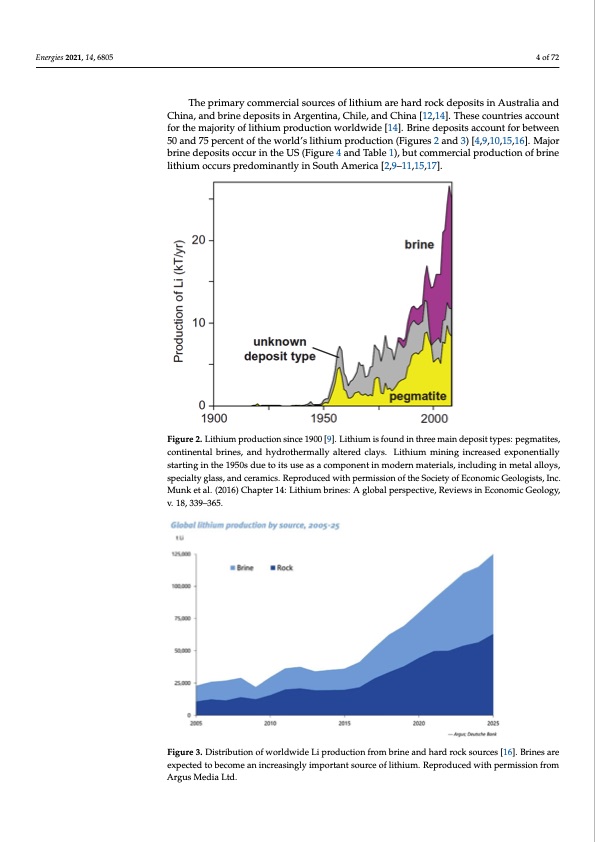
PDF Publication Title:
Text from PDF Page: 004
Energies 2021, 14, 6805 4 of 72 The primary commercial sources of lithium are hard rock deposits in Australia and Energies 2021, 14, x FOR PEER REVIEW 4 of 74 China, and brine deposits in Argentina, Chile, and China [12,14]. These countries account Energies 2021, 14, x FOR PEER REVIEW 4 of 74 for the majority of lithium production worldwide [14]. Brine deposits account for between 50 and 75 percent of the world’s lithium production (Figures 2 and 3) [4,9,10,15,16]. Major brine deposits occur in the US (Figure 4 and Table 1), but commercial production of brine brine deposits occur in the US (Figure 4 and Table 1), but commercial production of brine brine deposits occur in the US (Figure 4 and Table 1), but commercial production of brine lithium occurs predominantly in South America [2,9,10,11,15,17]. lithium occurs predominantly in South America [2,9–11,15,17]. lithium occurs predominantly in South America [2,9,10,11,15,17]. Figure2.Liithiumproductionsince1900[9[9]]..LLitihthiuiumisisfofuounnddininthrtheeremeaminaidnepdoepsiotstiytpteysp:eps:egmatites, Fpiegumreati2t.esL,itchoinutminepnrtoaldubcrtinoens,sianncde 1h9y0d0ro[t9h]e.rLmiathlliyumaltiesrefdouncldayisn. Lthitrheieumaminindinepgosinitcrteyapsesd: continental brines, and hydrothermally altered clays. Lithium mining increased exponentially pexepgmonaetnitteisa,llycosntatirntienngtainl tbhrein1e9s5,0sandduehtyoditrsotuhsermasaallycomalpteornedentclianyms.odLeitrhniummatemriianlsin, gincilnucdrienagseidn starting in the 1950s due to its use as a component in modern materials, including in metal alloys, emxeptoanleanlltoiaylsl,ysspteacritainltgyignlatshse, a1n95d0csedraume itcosi.tRseupsreoadsuacecdomwpitohnpeenrtminismsiondeorfnthmeaStoerciaeltsy, oinfcElucodninogmiinc specialty glass, and ceramics. Reproduced with permission of the Society of Economic Geologists, Inc. mGeotalol galilsotsy,sI,nscp.eMciaulntykgeltasasl,.a(n2d01c6e)raCmhaicpst.eRre1p4r:oLdiuthceiudmwbitrhinpesr:mAisgsilonbaolfptheersSpoeciteitvye,ofREevcoienwoms inc Munk et al. (2016) Chapter 14: Lithium brines: A global perspective, Reviews in Economic Geology, GEceonlogmisitcs,GIenocl.oMgyu,nvk.1e8t,a3l3.9(–2306156.)Chapter14:Lithiumbrines:Aglobalperspective,Reviewsin Economic Geology, v. 18, 339–365. v. 18, 339–365. Figure 3. Distribution of worldwide Li production from brine and hard rock sources [16]. Brines are Fexigpuercete3d. DtoisbterciboumtieoannoifnwcroeraldsiwngidlyeiLmiporortdauncttsionurfcreomofblirtihnieuman.dRhepardodruockedsowuirtchepse[1rm6]i.sBsrioinefsraorme Figure 3. Distribution of worldwide Li production from brine and hard rock sources [16]. Brines are eAxrpgeucsteMdetodibaeLcotdm. e an increasingly important source of lithium. Reproduced with permission from expected to become an increasingly important source of lithium. Reproduced with permission from Argus Media Ltd. Argus Media Ltd.PDF Image | Recovery of Lithium from Geothermal Brines

PDF Search Title:
Recovery of Lithium from Geothermal BrinesOriginal File Name Searched:
energies-14-06805-v2.pdfDIY PDF Search: Google It | Yahoo | Bing
Product and Development Focus for Infinity Turbine
ORC Waste Heat Turbine and ORC System Build Plans: All turbine plans are $10,000 each. This allows you to build a system and then consider licensing for production after you have completed and tested a unit.Redox Flow Battery Technology: With the advent of the new USA tax credits for producing and selling batteries ($35/kW) we are focussing on a simple flow battery using shipping containers as the modular electrolyte storage units with tax credits up to $140,000 per system. Our main focus is on the salt battery. This battery can be used for both thermal and electrical storage applications. We call it the Cogeneration Battery or Cogen Battery. One project is converting salt (brine) based water conditioners to simultaneously produce power. In addition, there are many opportunities to extract Lithium from brine (salt lakes, groundwater, and producer water).Salt water or brine are huge sources for lithium. Most of the worlds lithium is acquired from a brine source. It's even in seawater in a low concentration. Brine is also a byproduct of huge powerplants, which can now use that as an electrolyte and a huge flow battery (which allows storage at the source).We welcome any business and equipment inquiries, as well as licensing our turbines for manufacturing.| CONTACT TEL: 608-238-6001 Email: greg@infinityturbine.com | RSS | AMP |